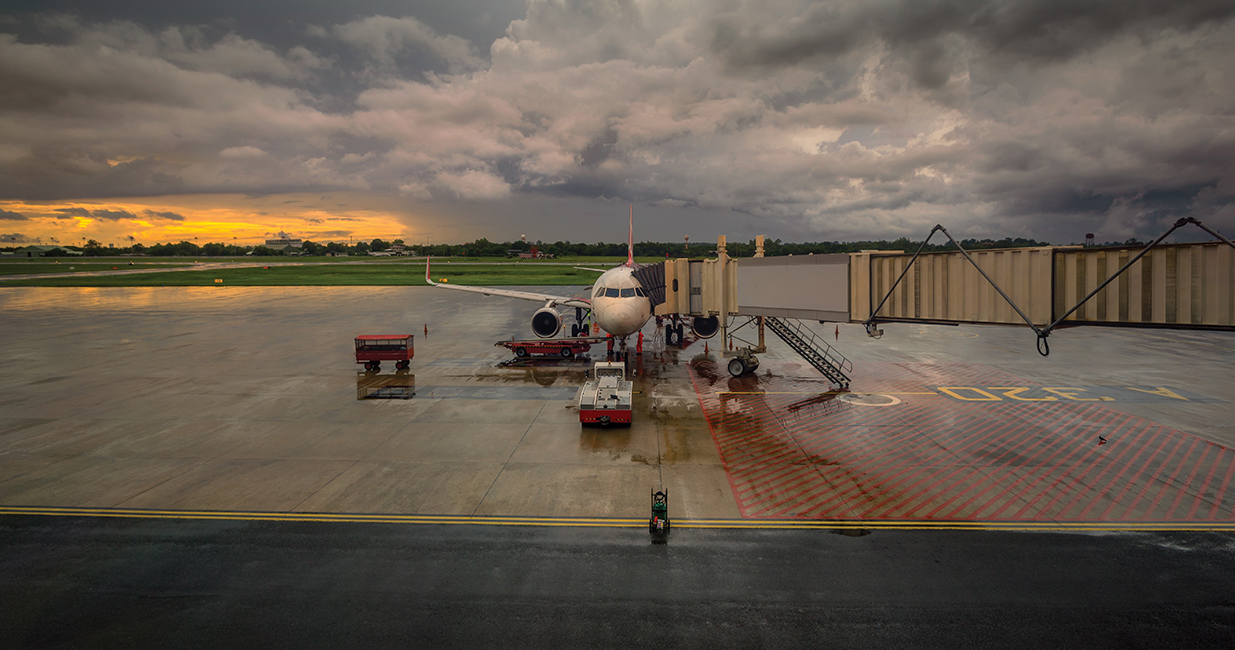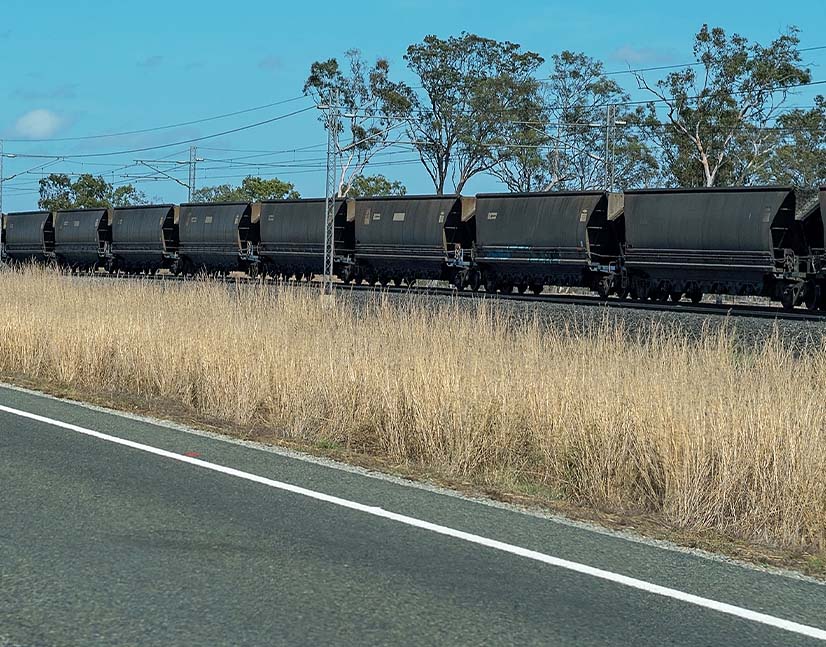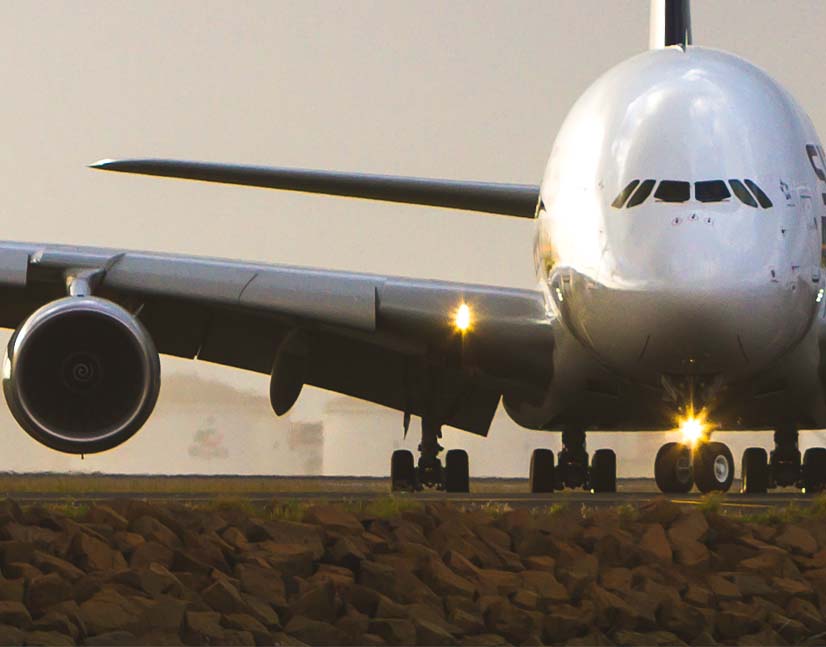
Eye of the storm
When Australia went into lockdown, transport and shipping infrastructure saw an unprecedented business shock. Airport and toll-road passenger numbers collapsed while even freight flows dropped as the global economy ground to a halt. In October, KangaNews and Westpac Institutional Bank gathered key players in the Australian sector to discuss business impact, balance-sheet resilience and the swift rebound of debt capital markets including the domestic option.

AIRPORTS GROUNDED
Blix Airports have been among the businesses most affected by COVID-19. What have been the impacts and how have issuers in the sector responded?
VAN DER GEEST I recall being in Europe in early February and talking through what the risks could be as they were emerging. It soon became a case of ‘scenario planning on steroids’. Every week the impacts we were working through kept increasing.
This means not only the risk to underlying passenger performance and the impacts to the business but also our response to the changing conditions. We saw significant impact on overall monthly revenue – passengers are now down 98 per cent on pre-COVID-19 levels, which clearly has a big impact on revenue across the business. Airports are passenger driven and the true diversification of revenue is within the property portfolio.
COVID-19 has been a seismic shock, followed by the response: from curtailing our major capex programme to managing the cost equation and a forensic approach to cash flow and collections. It has been a dynamic working environment across the business that includes managing every lever.
Melbourne is still in stage-two lockdown as of mid-October and everyone has been working from home for six months or so. There are signs, with decreasing COVID-19 caseloads, that we will come out of this soon and we can begin the recovery – as will all other members of the aviation industry.
BRIGGS We have similar themes albeit with comparatively less impact over the last 3-4 months. We have also had the benefit of strong intrastate travel within Queensland – this has performed above expectations.
Even so, revenue was effectively switched off in the June quarter. We were down 10 per cent in year-on-year revenue with EBITDA down 25 per cent from 2019.
Sitting here today, domestic travel has recovered to some extent but is still down by 75 per cent year-on-year. International travel remains a sad story – we are seeing around 300 passengers per day through our international terminal where we would normally see 5,000-6,000. At headline level this means our revenue continues to be severely affected.
A key issue we’ve been addressing is the relatively fixed nature of our cost base. We’ve been working closely with our suppliers to achieve cost savings and this remains a key focus for Brisbane Airport.
GOLDING We saw the impact quickly from the end of March. We held up quite well while restrictions only applied to international travel but we felt the effect immediately once domestic restrictions came.
In the June quarter, our passenger numbers were down by 96 per cent. But the diversification we have through property meant our revenue was only down by around two-thirds.
We are predominantly a domestic airport and South Australia’s borders have opened sooner than other states, so we are back up to around 30 per cent of normal domestic passenger numbers. It feels as though we are starting to see a recovery.
MOMDJIAN Passenger numbers have been down by more than 90 percent since April. Of course, this has affected our revenue. We reported our half-year results showing revenue down by 36 per cent, which followed a 57 per cent decline in passengers half-on-half, highlighting the benefit of diversified income streams.
In response, we reduced controllable operating expenses by more than 20 per cent over the half-year, with a target of reducing operating expenses by at least 35 per cent for the 12 months to March 2021.
We also reduced our capex guidance by more than 50 per cent, with a target of A$150-200 million (US$107.7-143.6 million) in spend over the same period. We did not pay a distribution for the first half of 2020 with no distribution expected for full-year 2020. Our response has been swift and decisive.
The future is bright, though. New South Wales is currently open to South Australia, Northern Territory and, hopefully, other states soon. Then there is positive momentum around the trans-Tasman travel bubble, with one-way incoming travel without quarantine operational later this week. This should provide a template for opening to other international jurisdictions – assuming all goes well. The momentum is there and a recovery is on its way.
Domestic market evolution
Australia’s corporate bond market took years to recover after the financial crisis in 2008-9. The rebound after COVID-19 came in a few months – and market conditions are arguably better than ever for issuers.
MCKAY The performance of the domestic bond market has been exceptional. The two highlights for me have been the size and depth of order books, with transactions being well oversubscribed, and the ability to execute intraday. This is a big positive.
We are used to seeing these conditions in global capital markets, but to see this growth in the Australian market is a really strong development. Our recent experience with the Westlink M7 AMTN issuance was testament to these positive developments.
Davison There was a small bounce in domestic travel in July and it was expected to increase strongly into August – until the Victorian lockdown. What are the prospects for airports if the domestic reopening is slow and international travel a long way off?
MOMDJIAN We are optimistic. It is not a pipe dream to think that most if not all borders will soon open domestically. There is significant pent-up demand from people wanting to see their families and friends, as well as those itching to go on holiday – which will help fuel a solid domestic recovery as lockdowns ease.
Rapid domestic improvement has already been demonstrated in parts of Asia, with a recovery of close to or greater than 100 per cent in some countries. On the international side, the opening of a trans-Tasman bubble will provide additional choice.
The recovery of business travel may take a little longer, but anecdotally our local and offshore debt investors are welcoming some face-to-face interaction.
BRIGGS We saw a strong, and much better than expected, response domestically in May and June when economies appeared to be opening again. We were tracking toward 40 per cent of domestic passenger volume going into June. With the Victorian lockdown this went off the boil again. There is a question mark over whether we will see such a strong response again. There is probably more caution around the economic position of the country and individual job security now. We still expect a reasonably strong ramp up but do not expect domestic traffic to return to 2019 levels until 2023. It will probably be a bit longer for international.
We expect the domestic story will be supported somewhat by substitution travel. People will not have the option to travel overseas for a while so hopefully some of that spend will be applied to domestic travel.
I agree that the big question mark continues to be around the business-travel market. Around 40 per cent of our domestic travel is business-related. By the time things reopen people will have had close to 12 months of virtual meetings rather than doing intraday business travel between Sydney, Brisbane and Melbourne. There is a query around how firms respond to the pandemic and there is no doubt this will be a big swing factor for a full recovery.
VAN DER GEEST The economic recovery will also dictate to an extent the recovery of domestic travel outside leisure travel. Some of the key focus areas we all need to work on are opening borders safely and getting economic travel to start and to prosper. The corridors between Melbourne, Sydney and Brisbane need to open to help drive economic growth across the country.
There is also the smaller Virgin Australia – once it begins operating again – which has taken some capacity out of the system.
All the airports are working with the assumption of a domestic-led recovery. A trans-Tasman bubble will help work out how to do international travel safely. Once this happens, we can look at opening to other parts of the globe – whether it is to specific tourist destinations or to other countries around the world that have handled the pandemic well.
Safety is front and centre. But we all want the opening of domestic borders, to support the broader economic recovery and response.
GOLDING Being a primarily domestic terminal we see a lot of opportunity in the pent-up demand for travel and have already seen a strong response as borders have opened. We are also seeing more domestic tourism interest in South Australia given the limitation on overseas options. There has been a strong initial rebound but we expect it will be a slow path back to FY19 numbers, probably including a permanent impact on business travel.
“We formed a clear view about how bad things would get. The unknown factor was for how long the downturn would persist and what the recovery would be like. Ultimately, though, if you want to get around Australia you need to fly. We believe there will be desire for travel – for leisure and, eventually, business too.”
Sustainability factors
While labelled bond issuance from the Australian corporate sector is only starting to fire in the closing months of 2020, market participants say the level of focus on environmental, social and governance (ESG) issues has only increased – including in debt transactions.
CHEN When COVID-19 hit Australian shores in March, we thought the sustainable finance market may slow down considerably. Little did we know it would be anything but. Climate change has only grown as an issue. Week after week, investors have come out to announce how their funds are to be aligned with the Paris goal of net-zero emissions by 2050.
But what is interesting about the COVID-19 period is the growing interest in the social aspect of ESG, which has previously been a poor cousin of green and governance concerns. As a sustainability practitioner, it is good to see social issues gaining prevalence.
Davison How do institutional investors deal with the type of impact on revenue the airport sector has seen?
LEWIS We look at the long-term value of these assets and in this context we continue to see significant value in airports over an extended time horizon. There is a short-term creditworthiness issue that may extend to a couple of years and will depend on how the airports are financed and their access to funds from supportive owners.
Australia’s unlisted airports are predominantly owned by large infrastructure funds and experienced airport-sector operators. These owners are in a position to provide equity support if required by the airport. Meanwhile, listed airports have the ability to access capital markets directly by issuing shares or hybrid capital.
Early on in the COVID-19 shock in March-April, we looked at immediate access to liquidity and got comfort from it. We also reviewed management strategies to see how airports could get efficiency in operational expenditure and the extent to which they had deferable capex.
Of late, we have seen quite a lot of capital-markets issuance where operators have sought to term out bank debt and preserve their committed bank lines to maintain access to liquidity should things worsen again.
Some airports are in a better position than others – specifically those with fly-in, fly-out and intrastate traffic have weathered the storm a little better. Those more dependent on international travel are clearly taking more pain.
As a debt provider, we take the view that it is always worthwhile to work with the borrower if an asset gets into trouble. This has come to the fore even more in the current environment because the problems are not a result of mismanagement.
These are essential assets so we want them to be viable. Everyone has to do their bit to try to exercise what flexibility they have to support them through this extremely difficult time.
DAVID It is amazing to think that we used to look at airports and fret about whether they were growing revenue by 3 or 5 per cent, or earnings by 6 or 8 per cent. This all seems quite superfluous now.
When the pandemic hit, initially we wanted to get a clear sense of how bad things would get. This became apparent quite quickly when traffic slowed to a few per cent of what it once was.
The disclosure the sector has provided is helpful for us. Airports have offered monthly and even intramonthly updates, revenue and earnings disclosure, and segmental breakdowns. This has allowed us to be confident in our decisions.
We formed a clear view about how bad things would get. The unknown factor was for how long the downturn would persist and what the recovery would be like. Ultimately, though, if you want to get around Australia you need to fly. We believe there will be desire for travel – for leisure and, eventually, business too.
The final piece of the puzzle is liquidity. We started off by assuming cash burn for a period and no access to capital markets. But the airports have very strong liquidity positions with a very healthy buffer they can chip away at in the event COVID-19 lasts longer than anyone expects.
This backdrop gives us comfort that the airports are all in a pretty good position to hibernate while COVID-19 lingers. With some luck, we will come out quicker than expected. A vaccine would obviously be a game changer but, even in its absence, the renewed prospect of a trans-Tasman bubble and beyond will support airports’ operating base.
Another factor is the pace at which airports have cut opex and capex. The speed with which capex projects were pared back was much greater than we ever thought possible. The sector responded proactively, which we valued very highly.
TRANSPORT INFRASTRUCTURE
Blix Port of Brisbane’s trade numbers are down in 2020 but clearly not as dramatically as airport traffic. What has been the port’s experience through this period and how have expectations around factors like export volume changed?
TRIGGELL It is certainly a different dynamic for performance than it is for the airports. To give some context, the port has a very diverse revenue base with roughly 45 per cent of our revenue derived through trade and 45 per cent through property.
When COVID-19 first hit there was a lot of uncertainty about the impact on trade. We saw a lot of Chinese manufacturers shut down and 14-day quarantine periods were placed on ships visiting Australia. This initial impact hit trade volume due to supply-chain constraints.
We have emerged well since then. We were down in FY20 trade volume by around 7 per cent and revenue by 5 per cent. The revenue side was partially offset by increased property revenue, though, so overall revenue was flat for the year. This was a pleasing result given the backdrop.
In the current year to date, we are down marginally on trade revenue but property has remained stable. Overall, supply chains are now operating freely and we are well positioned.
However, future trade flows will always be linked to how well the economy is tracking. As long as supply chains are open, we expect core trade volume to remain robust.
Blix Port of Brisbane also has a cruise terminal. What is the outlook for this sector?
TRIGGELL The cruise facility was completed in July but obviously there are still a lot of unknowns in the industry. The federal government extended its ban on international cruise vessels until mid-December so the outlook for cruise visits in the current year is uncertain and hinges on when the ban is lifted.
Forward bookings beyond the current cruising year are strong, however – and we are confident in the outlook for the cruise industry in the long term.
Blix Aurizon reported a small increase in revenue for FY20. What is the basis for this robust relative performance and how is the impact of the pandemic being felt in the company’s business and financials?
VAGG We have been fortunate in that COVID-19 has not had a material impact on Aurizon so far. Demand for metallurgical and thermal coal, as the principal commodity we are involved in, has remained solid.
The only concern we had initially was on the effect of government restrictions on workers being able to get to and from customers’ mine sites. However, early on mining was deemed an essential service and therefore everything supporting it, including rail, was also deemed essential. This was a good outcome for us.
As a listed company, we had financial guidance in the market. We had to scenario test this extensively but did not need to adjust it. We hit the middle of the range and maintained our dividend and capital management. This was a pleasing outcome.
We have also not seen any impact on customers’ ability to pay – there has been nothing material, whether it be extension or rate-reduction requests.
All this said, there will be an impact this year because COVID-19 has caused global recessionary conditions. Around 90 per cent of the coal we touch is exported and 95 per cent of it is exported to Asia. COVID-19 cases are peaking in India, which is the number-one destination for metallurgical coal exports from Australia. The Indian government has lockdown measures in place and this affects the demand for steel and, in turn, for metallurgical coal.
For this reason, we have indicated that volume will be a bit soft in the current half-year. We think it will recover in the second half and forecast volume to be flat this year compared to last. Earnings will be a bit lower because of the way our network business works around timing of revenue recognition.
“The only concern we had initially was on the effect of government restrictions on workers being able to get to and from customers’ mine sites. However, early on mining was deemed an essential service and therefore everything supporting it, including rail, was also deemed essential.”
Blix How significant has the impact of restrictions been across Transurban’s asset portfolio?
MCKAY We recently released our latest traffic data, covering the period from July to September 2020. The data provides an informative snapshot of when and where people are returning to our roads, and helps paint a clearer picture of how our various assets are recovering.
While traffic declined quickly from early March and into mid-April – when most of our markets were experiencing their peak restrictions – we saw it improve steadily through May and June as restrictions were progressively removed.
Our recent traffic data release highlights that Sydney and Brisbane are performing well given the circumstances, with Sydney traffic up 1.5 per cent driven by the contribution of the M8 and M5 East from July, and Brisbane traffic down 9.1 per cent. As you would expect, our roads that service airports continue to be more affected than others.
It will also come as no surprise that CityLink traffic has been affected by the reintroduction of restrictions in Melbourne – it is down 58.6 per cent this quarter. We expect traffic will remain sensitive to government responses in each market.
It is important to remember that CityLink is one of 20 roads we operate around the world, and our experience in other cities suggests traffic starts to recover quickly when restrictions ease, particularly for the more sensitive passenger-vehicle sector.
Pleasingly, large vehicles continue to be resilient despite restrictions, and were down just 18.8 per cent in Melbourne in the third quarter. Of these, heavy commercial vehicles were down only 7.2 per cent for the quarter.
In North America, traffic was down 28.2 per cent for the quarter, with the A25 outperforming our Express Lanes assets.
Davison One of the things we have seen as a result of the pandemic is that when people return to work, at least initially, they are more likely to travel in their own cars than to use public transport. Is Transurban seeing any data to suggest longer-term trends in how people travel?
MCKAY Transurban recently commissioned research into urban mobility trends after COVID-19, by surveying nearly 4,500 people across Australia and North America.
The findings from our research show that commuting to the office is unlikely to disappear as 86 per cent of respondents believe they will not significantly increase the amount of time they work from home following the pandemic.
Personal health and safety is likely to dictate the ways people move around cities. Here, 25 per cent of respondents expect to decrease their public-transport use post the pandemic.
On the other hand, growth in online shopping is likely to continue: 48 per cent of respondents report shopping online more during the pandemic and half of those expect to continue doing so after it.
These mobility trends suggest we may see a level of disruption across transport modes for some time to come. It’s an opportune time for governments and industry to work together to ensure we have efficient and resilient transport networks into the future.
Many options – from flexible working hours to leveraging data and technology – should be part of the conversation. We also need integrated transport networks that help spread peak travel periods and give people choice in how they want to travel.
Davison It would be interesting to get a buy-side view on this type of development. Are investors thinking some demand and revenue patterns will be completely reshaped by COVID-19?
DAVID We forecast everything but all I know for certain is that these forecasts will be wrong! It looks like there will be more flexibility in the workplace going forward and this may mean there are fewer people in the office. But we do not envisage a world where we are all working from home all the time. There are some things you just cannot do productively on your own – not to mention fostering a workplace culture. There is a need to be together.
When we forecast the airports, we expect domestic and international travel will resume but there are differences in how each segment will come back to pre-COVID-19 levels.
It may be the same with the toll roads – some will do better than others. A lot of it comes down to the corridors and customers they are serving. We use forecasts to provide a glimpse into what may unfold but we are aware that no scenario will play out exactly as we expect.
LEWIS Humans tend to be creatures of habit and can be expected to revert to their behaviour from before the pandemic. If the SARS epidemic and terrorism have not scared people off flying permanently, I think they will revert back to normal pretty quickly after COVID-19 is under control. It will most likely be led by a need for leisure travel as everyone will want a holiday after the pandemic is over.
Regarding toll roads, it is true that there will be some initial aversion to public transport and this will be to the benefit of toll roads. But we are also seeing people’s behaviour becoming much more responsible on public transport – including wearing masks and carrying hand sanitiser. Previously, the only people who wore masks on public transport were probably those who had lived through SARS in Asia. But it is now customary to wear a mask.
We try to consider long-term viability beyond the crisis. It may sound strange coming from debt investors – who are generally seen to express doom and gloom – but with this situation we see value in being a bit more visionary about where things are heading.
Covenant control
Confronted with an unprecedented shock to operating conditions, Australian transport infrastructure borrowers encountered a largely supportive environment for amending debt terms and conditions.
GRACE During March and April there was a lot of concern internally about what would happen. No-one knew how long this would go for. All the banks became internally focused on looking at existing portfolio names and trying to work their way through their own back books. This process was to determine which companies would be exposed and to what extent.
At the same time, we were getting a lot of amendment and waiver requests, as well as requests for liquidity lines. Everyone was trying to right their own ships during this time of uncertainty.
The bank was nervous about what the impact on funding would be. We had seen what happened during the financial crisis when there was difficulty in funding markets. There was also concern around portfolio names and what would happen to them.
BALANCE-SHEET POSITION
Blix To what extent can businesses prepare for once-in-a-lifetime events like COVID-19? Are issuers comfortable that their contingency planning prepared them for any reasonable eventualities, or are events like this simply outside the scope of planning?
GOLDING We never planned for a scenario of no revenue for an extended period. Our pandemic modelling has previously been based around SARS. We are in the middle of a terminal expansion project and had prepared our balance sheet to withstand a SARS-type pandemic through this as well as a charge reset coming up in 2021.
As part of this preparation, we boosted our cash balances, and secured liquidity and funding for the terminal expansion right through to completion as well as for the rest of our capex plans during this time. We also pushed all our maturities out because we didn’t want to be refinancing in the middle of this situation. We have no debt maturities until 2023.
The work we did has held us in good stead through COVID-19. We secured additional liquidity from our existing bank group but haven’t needed to draw on this and don’t expect to for some time.
BRIGGS As we have all talked about, COVID-19 was a pretty big shock. We made some quick decisions around liquidity. For instance, we were in the market considering a capital-markets transaction but we had to shelve that and move to put a bank facility in place.
We have policies covering the amount of liquidity we aim to hold that consider the volume of obligations over the next 24 months. It is fair to say we are reviewing these policies given what has transpired in the last six months.
It is broader than just balance sheet, though. We are looking at aeronautical pricing, how we structure our deals, and assumptions made over the years about the reliability of investment-property revenue and tenant retail leases. It’s not practical to operate a business while planning for these sorts of tail events, though, because doing so would be highly limiting.
Six months on, we are in a very strong liquidity position and we are comfortable with where our policies are at the moment. But they are subject to review over the next 6-12 months.
VAN DER GEEST Events such as COVID-19 can never be modelled. What can be considered is how to respond to shocks. The key difference between 2020 and the financial crisis is that we are not experiencing a liquidity event. The goal for Melbourne and other airports was to prioritise and secure liquidity first – and the way banks responded to the pandemic crisis was very pleasing.
This and other shocks really show the importance of the breadth of a banking group and strength of relationships. In a time like this, being able to reach out and get additional bank lines is vital. Doing so depends on having diversity in the bank group and banks that can support you.
When it comes to preparation, we had recently procured term debt in the capital markets and had quite a lot of available liquidity in undrawn bank lines. This stood us in good stead but we also sought further to increase our level of liquidity, providing the airport with a cushion to see us through the turbulent times.
Where we are today – and where I think all the airports are – is with sufficient liquidity and with our attention focused on getting underlying trading performance back on track. We are waiting for the bounce and aiming to manage cost control on the way back up.
Cash-flow forecasting has been a big part of the process for us during the pandemic – understanding downside scenarios and testing them against covenant and liquidity limits to ensure we have an appropriate buffer. We have always done this, but I think the pandemic has heightened the focus.
MOMDJIAN We have learned from diverse shocks since Sydney Airport was privatised in 2002. We have also spent significant time carrying out scenario analysis, identifying risks and – importantly – their mitigants. But it is clearly difficult to prepare for a once-in-a-lifetime event of this breadth, length and severity.
Proactive capital management is part of our DNA, though. Aside from the minimum liquidity requirements set out in our policies, the strength of our balance sheet and our well-spread, lengthened and diversified maturity profile afforded us the ability to shift our focus away from reactively responding to the pandemic.
Instead, our goal has been further to strengthen our balance sheet such that we are well positioned under a range of recovery scenarios, regardless of its shape or pace, and are able to capitalise on future growth opportunities as they arise.
We entered the pandemic with more than A$1.7 billion in cash and undrawn debt – already enough to fund all our debt maturities until the end of 2021. We went over and above to establish A$850 million of bilateral bank-debt facilities and raise A$2 billion of equity, bolstering our liquidity position while optimising leverage. We were not forced to access debt capital markets, particularly at a time when margins and all-in funding costs had spiked.
In taking our liquidity position to more than A$4.5 billion, our bank group – domestic and offshore – was very supportive. A few banks even tried to use the pandemic as a way of entering our bank group, which came as a surprise given the circumstances but highlights a focus on core business fundamentals and long-term credit quality.
Blix Has the pandemic forced a relatively unaffected company like Aurizon to rethink liquidity policies?
VAGG Our board is focused on liquidity even though we were relatively unaffected. I was constantly questioned about it – about whether our policies and thresholds were sufficient.
We made some changes to timing. We were planning on issuing in the Australian market in March and we did our deal roadshow in the last week of February – which was when COVID-19 was blowing up from a capital-markets perspective. The relevant maturity was in October but we had to shelve the new deal quite quickly.
The subsequent plan was to refinance our bank facilities and we went ahead with this in March. We then took the opportunity to increase our capacity by establishing a new bank line and converting it to a bilateral facility from a syndicated one. We were doing this in the eye of the storm, but our message was that the business was largely unaffected.
The process took a lot longer than it normally would but we received good support from our banking group as well as introducing a few new lenders to increase our capacity by about A$400 million. This was so we could cover our bond maturity only a couple of months later. Although the bond markets were already starting to open up, we decided to take a conservative option.
The message from our board was not to focus too much on cost or to keep just the bare minimum of liquidity needed. They gave their support to be conservative. We closed the bank-debt refinancing in June and bond markets opened up pretty quickly after that, so we were able to issue a bond in August.
We now have ample liquidity and undrawn bank lines. We have left the facilities there for now because, again, the message from the board has been to take our time to think about what liquidity we will need over the next couple of years. We are in no rush to adjust those bank lines but the ultimate strategy will be to term some of them out in capital markets in the future.
It was good to have support from our board about not focusing on achieving the lowest-cost bond transaction. It is important to get the right mix of investors participating in a deal, as well as the right mix of banks in our facility and the right maturity profile.
TRIGGELL Our policies guided us very well through the eye of the storm. We came into it having experienced a heavy period of capex spend with the motorway upgrade and the cruise-facility project over the last two years. Still, we had a good level of headroom in our bank facilities.
We began a debt capital markets issuance process in February-March to fund a maturing bond. We quickly shelved this and turned to the bank market, which was extremely accommodative.
Once we saw calm return to markets, we proceeded with bond issuance locally in July and achieved a great outcome including pricing not materially different from pre-COVID-19 levels. The main objective for our bond issuance was to clear our 2021 calendar-year refinancing obligations and to create space until the next refinancing process, as the outlook in financial markets was uncertain.
Cash-flow forecasting has been a big part of the process for us during the pandemic – understanding downside scenarios and testing them against covenant and liquidity limits to ensure we have an appropriate buffer. We have always done this, but I think the pandemic has heightened the focus.
Blix Transurban is one of Australia’s most active corporate issuers in global markets. What was the ride like from its euro transaction in April – the peak of the pandemic – through to the recent US dollar deal?
MCKAY Global capital markets certainly provided an interesting backdrop to our capital-raising activities this year. Similar to other corporates, as the pandemic continued to grow we quickly took the decision to establish additional bank facilities primarily to cover the risk of a major dislocation to global capital markets.
We also continued to monitor global markets, though. By April, we had sufficient confidence to proceed with a bond transaction. We ultimately launched in the Eurobond market, where we expected to get best execution, and successfully priced a €600 million (US$706.6 million) 10-year bond.
During June, given the positive signals in the Australian bond market, we launched a domestic bond deal for Westlink M7. We were delighted with the response from our domestic investor base for this, eventually closing a A$155 million 10-year transaction.
During the second half of the year, we monitored conditions in the euro and US 144A markets. Given the strong rally that took place in the 144A market, we launched a deal there and were delighted with the response – ultimately pricing a US$900 million 10.5-year bond.
INVESTMENT CONDITIONS
Lucas Could investors speak to the period of maximum stress and specifically how important the Reserve Bank of Australia (RBA)’s term-funding facility (TFF) was to the market?
DAVID Across our platform, our funds aim to provide liquidity to our clients through all considerations. It is important that we treat all clients fairly, though – and when a market is severely dislocated liquidity can dry up very quickly.
If we just sold the bonds that were liquid, we would be selling a lot of high-quality bonds. We applied a sale spread on our funds that effectively allowed us to pass on the cost of accessing liquidity to clients who wished to use it, and thus not to penalise clients that chose to remain in the fund.
The RBA’s TFF started the thawing of liquidity in the market. We didn’t envisage the RBA following the [US] Federal Reserve and European Central Bank in becoming an active participant in the market. But we definitely saw it using the banks as the transmission mechanism to get liquidity to flow into the market and to corporate Australia, and thus indirectly to benefit the bond market. This was a trigger point.
A lot of excess liquidity investors were holding has been returned to the market. There is probably a little still on the sidelines, which is reflective of an environment where the economic outlook is still quite challenged with moderately high unemployment and a lot of businesses are suffering the effects of the COVID-19 lockdown. Investors are waiting to see what things are like when activity resumes again.
Lucas Has reduced bank issuance domestically affected fund managers’ demand for corporates – and is there more demand now for global names?
DAVID We have seen a range of new issuers come to the market of late, some within sectors that are quite affected by COVID-19. We have started to see corporate transactions oversubscribed to the same degree that we might typically see in Europe and the US. It was not previously common to see an Australian dollar triple-B corporate with a book of A$1 billion or more. This is frequently the case nowadays.
The range of investors chasing these transactions is significant and looks to be growing. This brings challenges because there is a lot of competition to get access to deals in the volume we want.
LEWIS We have seen an abundance of debt capital available for quality infrastructure assets. This reinforces the point that investors see value in infrastructure assets over the long term. There is certainly plenty of money chasing infrastructure debt exposure.
We have been significantly scaled from what we have bid in some transactions. This is good for the borrowers but it makes it hard for us to get invested in an asset that fits our portfolios.
















